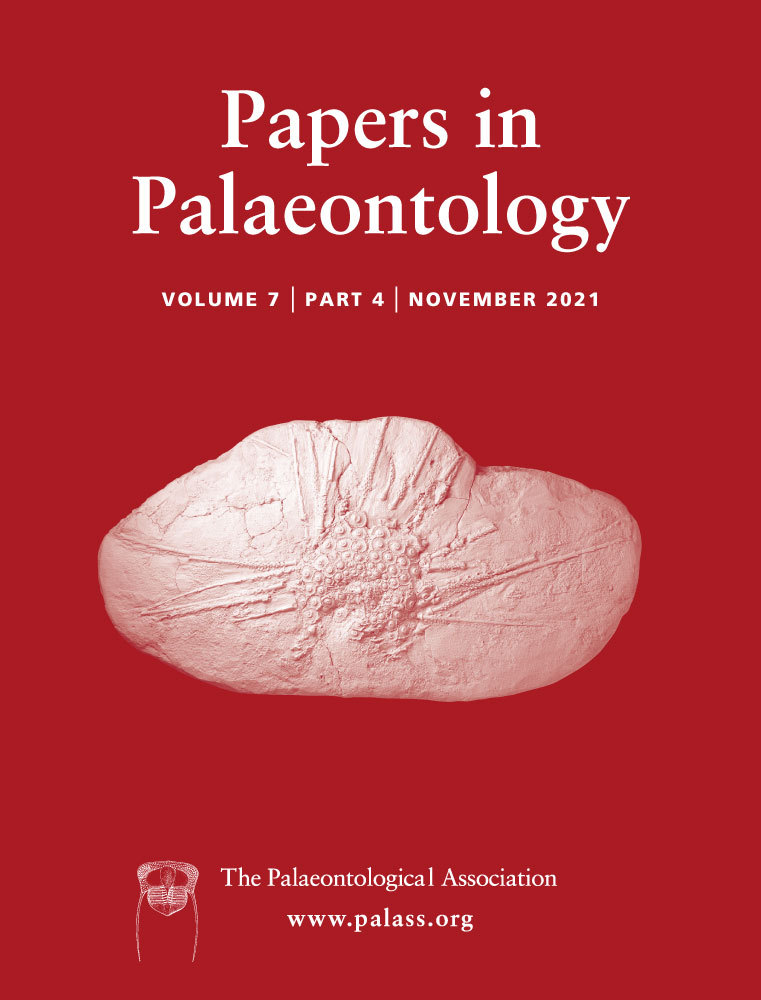Rosselichnidae ifam. nov.: burrows with concentric, spiral or eccentric lamination
Abstract
Burrows with a thick concentric, spiral or eccentric lamination are common constituents of Phanerozoic marine deposits and have been described under different names for more than 150 years. Ambiguous original diagnoses, questionable type specimens and morphological transitions between end members have led to a rather unstable ichnotaxonomy and varying indistinct definitions. This situation, in turn, hinders an application of these ichnotaxa in facies interpretations, and in palaeoenvironmental and evolutionary reconstructions. A revision of this group of trace fossils, collectively assembled under the new ichnofamily Rosselichnidae, aims for its consolidation. It includes the ichnogenera Rosselia Dahmer, Cylindrichnus Toots in Howard, Patagonichnus Olivero & López Cabrera, Artichnus Zhang et al., Lamellaecylindrica Knaust and Bromlichnus Vallon et al., together containing 15 ichnospecies. Burrow morphology, orientation, branching and type of lamination are used as ichnotaxobases. Artichnus serialis isp. nov. is erected, whereas Rosselia erecta (Torell), Rosselia prolifera (Fournier et al.) and Lamellaecylindrica ludwigae (Schlirf) are new combinations. Rosselia erecta is installed as the ichnospecies name for forms that historically have been assigned to Monocraterion isp. A review of established interpretations of potential producers and their ethology of ichnotaxa included in Rosselichnidae reveals that polychaetes and holothurians with a suspension- and deposit-feeding behaviour are best equipped to produce such burrows. The stratigraphic record of Rosselia spans the entire Phanerozoic, whereas the other ichnogenera mainly occur in the Mesozoic and Cenozoic.
Concentric, spiral and eccentrically laminated burrows are common elements of trace fossil associations, but their ichnotaxonomic assignment is often challenged due to variable morphology and transitional forms, for instance between branched and unbranched burrows. This particularly applies to burrows described as Rosselia Dahmer, 27; Cylindrichnus Toots in Howard, 57; Patagonichnus Olivero & López Cabrera, 97; Artichnus Zhang et al., 139; Lamellaecylindrica Knaust, 70 and Bromlichnus Vallon et al., 128. Nevertheless, proper identification and ichnotaxonomic description is crucial for their recognition and application to integrated palaeoenvironmental evaluations (Knaust & Bromley 71). Ichnotaxobases, i.e. the diagnostic characteristics of ichnotaxa, are key in this process (e.g. Bertling et al. 13; Knaust 66), although no uniform approach is applicable to all ichnotaxa due to a wide spread of morphologies and compositions (Rindsberg 110).
One solution to the dilemma of morphological variability and gradational burrows would be to broaden the ichnogeneric diagnosis to encompass several morphologically different ichnospecies, in contrast to a narrow ichnogeneric diagnosis that includes only one or a few closely related ichnospecies. The common ichnogenus Rosselia serves as a good example, in which an extended original diagnosis allows for the inclusion of related ichnospecies formerly assigned to other ichnogenera.
One of these ichnospecies, Rosselia erecta, is a very common element of lower Palaeozoic sandstone beds, but until now it had no proper name due to ichnotaxonomic issues related to an unclear situation regarding its syntypes. Branching, often used as an ichnotaxobase, seems to be less applicable at the ichnogenus level if secondary successive branching occurs only sporadically, but it may be used to distinguish ichnospecies (e.g. R. prolifera and Cylindrichnus candelabrus). The manner of fill, such as the development of laminae (e.g. R. rotatus) and the proportions of the passively filled tubes (e.g. R. erecta and R. socialis), are further Rosselia-specific ichnotaxobases. However, applying a combination of several ichnotaxobases for the distinction of Rosselia ichnospecies bears the risk of encompassing too many combinations that might be realized in nature. For instance, the manner of aperture fill results in three unbranched ichnospecies (R. erecta, R. socialis and R. rotatus), and the same number of combinations theoretically exists for branched Rosselia.
A clarifying note is necessary to explain the terms ‘active’ and ‘passive’ burrow fill. In the description of trace fossils, burrow fill is commonly assumed from the activity of the trace maker, and it is termed active if contemporaneously and actively filled by it, or passive if subsequently and passively filled by sedimentary processes. In thickly laminated burrows such as Rosselia, this situation becomes complicated because most parts of the burrow can be actively laminated due to continuous lining of the burrow margin, and only a fraction of the burrow (i.e. the terminal causative tunnel) is passively filled after its abandonment. In that case, the process of a final passive fill of an actively lined (filled) burrow would result in a burrow predominantly consisting of an active fill and only subordinately of a passive fill (Fig. 1). Common procedure is to call a burrow actively filled if this proportion volumetrically dominates the burrow.
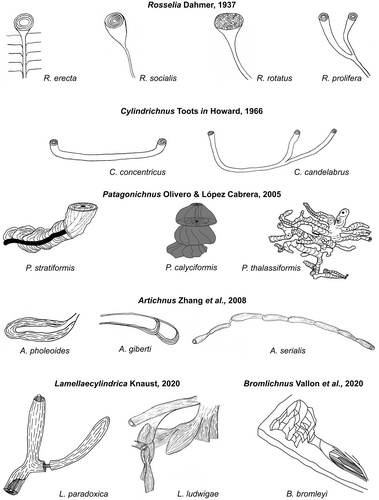
As with many other trace fossils, ichnotaxa included in Rosselichnidae ifam. nov. are far from being uniformly defined, but morphological transitions between different forms are rather the rule than an exception. This situation is one of the reasons why several common ichnotaxa still remain poorly defined by their diagnosis. Even relatively simple forms such as R. erecta can be mistaken for Skolithos linearis Haldeman, 50 if only the shaft is preserved, while its funnel shows transition to R. socialis (see Knaust et al. 73). Rosselia socialis, in turn, varies quite a lot with its laminated fill, while funnels with a crescentic and convoluted fill were described as R. rotatus, a form that also has been attributed to Parahaentzschelinia ardelia Chamberlain, 21. Moreover, vertical adjustment of the deeper (distal) part of J-shaped Rosselia may leave horizontally stacked laminae (spreiten), characteristic of Teichichnus Seilacher, 117, whereas lateral displacement of the shaft results in vertically arranged laminae. Vertically adjusted funnels produce cone-in-cone structures similar to stacked Conichnus Männil, 83 or Conostichus Lesquereux, 79.
A morphological series exists between vertical and inclined R. socialis and arcuate Cylindrichnus concentricus. Cylindrichnus concentricus, however, is the simple and unbranched expression of the more complicated and branched Lamellaecylindrica paradoxica, with which it occurs together. Lamellaecylindrica paradoxica has more or less uniform burrows, whereas L. ludwigae is characterized by bulbous enlargements. Patagonichnus with its three ichnospecies is a good example of a compound trace fossil in which many distinct components come together at various degrees. Likewise, Artichnus can consist of multiple elements with and without arcuate penetration of the sediment surface, as well as occurring isolated or in serial arrangement.
Based on the given ichnotaxobases, the aim of this ichnotaxonomic revision is to combine all burrows with a concentric, spiral or eccentric lamination under the new ichnofamily Rosselichnidae and to critically assess the included ichnogenera Rosselia, Cylindrichnus, Patagonichnus, Artichnus, Lamellaecylindrica and Bromlichnus and their respective ichnospecies.
Material and method
This revision is based on a critical literature review, the inspection of original specimens (i.e. syntypes, where available), photographs of syntypes that were currently not accessible, and numerous field specimens studied at type or otherwise relevant localities. If not identified by catalogue number, the figured material comes from outcrops and was not collected.
Institutional abbreviations
MW, Museum Wiesbaden, Germany; SGU, Swedish Geological Survey, Lund, Sweden; SMF, Palaeontological Collection of the Senckenberg Institute, Frankfurt am Main, Germany.
Systematic palaeoichnology
Ichnofamily ROSSELICHNIDAE nov.
Derivation of name
From its type ichnogenus Rosselia, whose name is derived from the locality Rossel, and -ichnus, meaning trace. Not to be confused with the family Rosselidae (hexactinellid sponges).
Diagnosis
Burrows with concentric, spiral or eccentric internal lamination.
Type ichnogenus
Rosselia Dahmer, 27.
Other ichnogenera
Cylindrichnus Toots in Howard, 57; Patagonichnus Olivero & López Cabrera, 97; Artichnus Zhang et al., 139; Lamellaecylindrica Knaust, 70; Bromlichnus Vallon et al., 128 (Fig. 1).
Remarks
The new ichnofamily is named after the ichnogenus Rosselia, its oldest, best-defined and most common member. It includes all concentrically, spiralled, eccentrically or crescentically laminated burrows independent of their orientation and branching. However, it does not include morphologically similar ichnogenera having ichnospecies with a simple lining (e.g. Palaeophycus, such as P. heberti; and Skolithos, such as S. linearis) or unidirectional lamination (e.g. Teichichnus, such as T. rectus; and Phycodes, such as P. circinatum). Rosselichnidae contrasts with Siphonichnidae Knaust, 67 by consisting of laminated instead of mantled burrows, although some ichnogenera included in the latter can be partly laminated (e.g. Scalichnus Hanken et al., 53). This also applies to Lennea Kräusel & Weyland, 74, a poorly understood plant-like burrow with spiral morphology and partly concentric lamination.
It would be tempting to include Asterosoma in Rosselichnidae, which, however, is a stellate burrow and therefore would be better accommodated in Brooksellidae Walcott, 130, whose type ichnogenus Brooksella Walcott, 130, however, may be a body fossil (Ciampaglio et al. 23). Moreover, in contrast to the common understanding (e.g. Häntzschel 54; Schlirf 114; Pemberton et al. 0103), the type ichnospecies Asterosoma radiciforme von Otto, 0101 from the Turonian of Königstein in Saxony, Germany, appears not to be laminated at all but is a passively sand-filled burrow (Niebuhr & Wilmsen 96; Fig. 2). It becomes obvious that stellate burrows with a thickly laminated fill and commonly assigned to Asterosoma would need an appropriate position within Rosselichnidae, or the ichnogeneric diagnosis of Asterosoma needs to be adjusted. This, however, would require a careful analysis of the type material of Asterosoma and related ichnotaxa and a re-evaluation of published specimens, which are beyond the scope of this contribution.
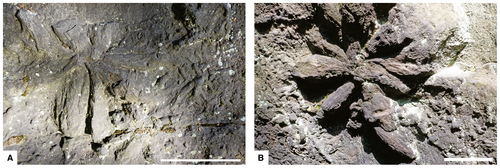
Ichnogenus ROSSELIA Dahmer, 27
-
- 124
-
- Micrapium Torell, p. 11–12
-
- 122
-
- Lepocraterion Stehmann, p. 17, pl. 10, figs 1–4
-
- 138
-
- Arctichnus Zakharov, p. 78, pl. 8, fig. 1
-
- 22
-
- Anemonichnus Chamberlain & Clark, p. 677, pl. 3, fig. 8
-
- 2
-
- Dolopichnus Alpert & Moore, pp. 228–229, figs 3–6
-
- 34
-
- Polycylindrichnus Fournier et al., p. 738, fig. 1
-
- ? 58
-
- Rosselia chonoides Howard & Frey, p. 208, figs 16–17
-
- non 1994
-
- Rosselia Forman in Forman et al., p. 603
Type ichnospecies
Rosselia socialis Dahmer, 27.
Revised diagnosis
(After Uchman & Krenmayr 126) Vertical to inclined, downward tapering, straight or curved burrow with a funnel-shaped, bulbous or fusiform aperture containing a thick concentric, spiralled or eccentric lining around one or several, passively filled, cylindrical tube(s). Secondary successive branching may occur.
Remarks
The revised diagnosis is mainly following the diagnosis given by Uchman & Krenmayr (126). Close analysis of numerous specimens from different Rosselia ichnospecies reveals a rather complex and highly variable internal burrow architecture, which has hitherto not been fully recognized. Beside concentric lamination, laminae that are arranged spirally or eccentrically occur as well.
Historically, Rosselia has been confused with Cylindrichnus, which displays a similar wall structure and fill to Rosselia (i.e. thick lamination). This particularly applies to early illustrations of Cylindrichnus, in which the steeply inclined to vertical burrow part is shown (e.g. Howard 57, fig. 10; Frey 36, fig. 9b; Frey & Howard 38, fig. 8.1). A restudy of the holotype of Cylindrichnus concentricus has demonstrated that it consists of a burrow with a broadly arcuate U shape (Ekdale & Harding 33), an overall geometry that is distinct from vertical to inclined Rosselia (Fig. 1).
The poorly known monospecific ichnogenus Micrapium can be assigned to Rosselia, based on syntype specimens of its type ichnospecies Micrapium erectum. This form is common in lower Palaeozoic sandstone beds and has been usually attributed to Monocraterion isp. in a broader sense. Lepocraterion consists of vertical shafts with a passive fill, funnel-shaped aperture and downward deflected adjacent laminae and also belongs to this group as a junior synonym. Arctichnus is identical to Rosselia, as suggested by Seilacher (118) and Popov & Shurygin (0106). Anemonichnus consists of vertical to inclined cones made of concentric sheaths and therefore can be assigned to Rosselia instead of Cylindrichnus, as suggested by Häntzschel (54).
Rosselia chonoides remains a dubious structure, consisting of a broad, funnel-shaped burrow with an irregular lobate outline and spreite-like feature, which connects with a thickly laminated vertical shaft. The ichnotaxonomic status of R. chonoides cannot be assessed until its type material is restudied, which should show if this form simply is a reburrowed Rosselia or if it belongs to a different ichnogenus (Uchman & Krenmayr 126). An inorganic origin resulting from soft-sediment deformation due to gas escape, which can produce similar structures, would be another option (see Hilbert-Wolf et al. 56, fig. 5).
The genus Rosselia Forman in Forman et al., 1004 belongs to the Kingdom Plantae and thus this name is regulated by the International Code of Botanical Nomenclature and does not compete with Rosselia Dahmer, 27.
Asterosoma isp. as described by Bromley & Uchman (16) from Lower–Middle Jurassic marginal-marine deposits of Bornholm, Denmark consists of a shaft with tubes leading up to a fan-like group of intersecting, steeply inclined spindles with a concentric lamination. These features fall into the diagnosis of Rosselia, in which this form should be included. Parts of Rosselia, if found in isolation, could be mistaken for Skolithos (e.g. its tube) or resemble Parahaentzschelinia Chamberlain, 21 (e.g. its funnel-shaped aperture).
Rosselia erecta (Torell, 124) comb. nov.Figure 3
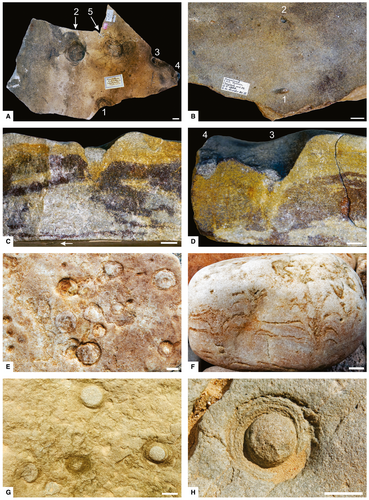
-
- * 124
-
- Micrapium erectum Torell, p. 11
-
- ? 0107
-
- Monocraterion lesleyi Prime, p. 79, pl. 5 [no lamination shown]
-
- non 85
-
- Monocraterion magnificum Matthews, p. 161, pl. 26 [= Monocraterion?]
-
- 122
-
- Lepocraterion Stehmann, p. 17, pl. 10, figs 1–4 [no ichnospecies name assigned]
-
- non 59
-
- Monocraterion clintonense Howell, p. 33, pl. 1, figs 1–2 [= Skolithos linearis]
-
- 2
-
- Dolopichnus gulosus Alpert & Moore, p. 224, figs 3–6
-
- ? 20
-
- Monocraterion maihari Chakrabarti, p. 147, fig. 12 [cone-in-cone structure without cylindrical tube]
-
- 137
-
- Monocraterion ningxiaensis Yin in Yin et al., p. 433, pl. 1, figs 2–4, 7
-
- ? 77
-
- Cylindrichnus karondiaensis Kundal & Sanganwar, p. 233, pl. 3, fig. 1 [only aperture is shown]
Revised diagnosis
Unbranched, subvertical Rosselia with a funnel-shaped aperture, in which the passively filled cylindrical tube is enlarged to occupy a major fraction of the funnel. Adjacent sedimentary laminae are commonly deflected downward.
Lectotype and paralectotypes
No holotype was selected by Torell (124) and no lectotype was designated subsequently. Type material from Torell (124) remains available in the Swedish Geological Survey (SGU) in Lund and conforms with his descriptions of Monocraterion tentaculatum and Micrapium erectum, although no explicit assignment to either ichnotaxon was made (Jensen 62). Sample SGU 5364 contains five funnel-shaped specimens, one with tentacle-like horizontal burrows, which Jensen (62) selected as the lectotype of M. tentaculatum. The other four specimens are without tentacle-like horizontal burrows and fit Torell's description of M. erectum. Therefore, these four specimens are regarded as syntypes of M. erectum, from which one specimen is herein designated as lectotype, whereas the other three become paralectotypes (Fig. 3A–D).
Remarks
Rosselia erecta is a common burrow, particularly in Cambrian sandstones (Fig. 3E–F), but also occurs in younger deposits, although its taxonomic assignment has been challenging. The lack of illustration and designated type material in its original description by Torell (124) has led to a poor understanding of Micrapium erectum and its confusion with the similar and co-occurring Monocraterion tentaculatum (e.g. Westergård 132; Jensen 62). Due to this taxonomic uncertainty, most workers have referred to Monocraterion isp. when dealing with R. erecta, which is unfortunate because Monocraterion describes a shallow funnel-shaped burrow with a central knob (passively filled cylindrical tube), from which numerous small burrows radiate (Schlirf & Uchman 115). The distinction made herein between shallow depressions with tentacle-like burrows (i.e. M. tentaculatum) and vertical cylindrical burrows with funnel-shaped top (i.e. R. erecta) should facilitate a proper separation of both recurrent ichnotaxa. Morphological variants of R. erecta may have a transition field with Rosselia socialis, with respect both to inclination and to the funnel-shaped enlargement of the cylindrical tube.
Some characteristics of R. erecta (Rosselichnidae) are shared with Laevicyclus parvus (Desio, 29) (Siphonichnidae), which is defined as a cylindrical vertical burrow with an actively filled mantle and a passively filled core, and an aperture that can be funnel shaped (Knaust 67). Although Laevicyclus is likely to be a preservation variant in the form of a hypichnial plug of an underlying vertical burrow aperture, little is known about the overall morphology of that burrow. Therefore, the usage of Laevicyclus is restricted to such ring-like features, whereas vertical burrows with a funnel-shaped aperture and internal lamination can be assigned to R. erecta. Consequently, Dolopichnus gulosus and Monocraterion ningxiaensis, previously included as junior synonyms in L. parvus by Knaust (67), are now regarded as synonymous with R. erecta.
Downward deflection of sedimentary laminae results in various figures in a sectional plane when cut in front, behind or in the plane of the vertical tube (Crimes et al. 24). Rosselia erecta is commonly reported from high-energy environments, which have frequent changes in erosion and deposition, and thus has various forms including single funnels, stacked funnels, concentric rings on bedding plane and simple cylindrical burrows (e.g. McIlroy & Garton 1007).
Producer and ethology
Polychaeta are good candidates for producing R. erecta, based on comparison with modern analogues (Alpert & Moore 2; McIlroy & Garton 2010), although Cerianthidae (Anthozoa) have also been discussed (Hallam & Swett 52). Suspension-feeding (dwelling) is the probable behaviour.
Stratigraphic distribution
Cambrian Stage 2–3 (Fig. 3E; Torell 124; Alpert & Moore 2) to Upper Cretaceous (Kundal & Sanganwar 77).
Depositional environment
Marginal marine (nearshore) to shallow marine (shoreface).
Rosselia socialis Dahmer, 27Figures 4, 5
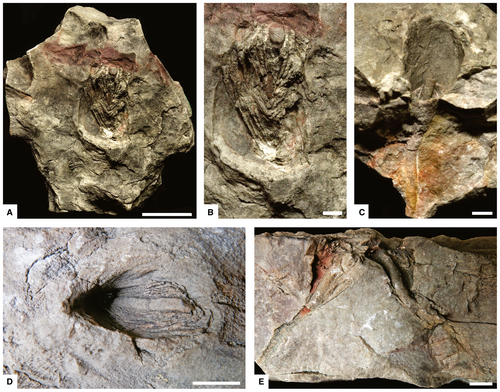

-
- * 27
-
- Rosselia socialis Dahmer, p. 532, fig. 2, pl. 31, figs 2–3, pl. 32, fig. 1
-
- 138
-
- Arctichnus arcticus Zakharov, p. 78, pl. 8, fig. 1
-
- 22
-
- Anemonichnus concentricus Chamberlain & Clark, p. 677, pl. 3, fig. 8
-
- 119
-
- Cylindrichnus japonicus Shuto & Shiraishi, p. 125, pl. 18, figs 3, 5, 6
-
- 123
-
- Cylindrichnus lusiaticus Suhr, p. 95, pl. 2
-
- 100
-
- Cylindrichnus operosus Orłowski, p. 218, pl. 15, fig. 3
Revised diagnosis
(After Uchman & Krenmayr 126) Unbranched, inclined to vertical Rosselia with a funnel-shaped or bulbous aperture with passively filled cylindrical tube(s) occupying a minor fraction of the funnel.
Lectotype and paralectotype
No holotype was selected by Dahmer (27) and no lectotype was designated subsequently. Syntype material remains available in the Museum Wiesbaden, Germany, from which the specimen figured in Dahmer (27, pl. 31, fig. 3; collection number 415) is herein designated as lectotype (Fig. 4A–B), whereas the specimen figured in Dahmer (27, pl. 31, fig. 4; collection number 416) becomes a paralectotype (Fig. 4C). Syntypes, originally deposited in the Bundesanstalt für Geowissenschaften und Rohstoffe (BGR) in Berlin (Dahmer 27, fig. 2, pl. 32, fig. 1), are apparently lost (Angela Ehling, pers. comm. March 2020).
Remarks
Although superficially resembling concentric lamination and generally described as such (e.g. Dahmer 27; Uchman & Krenmayr 126; Schlirf et al. 116), the fill of R. socialis is more complex and involves truncations, onlaps and portions containing spirally overlapping laminae. This becomes evident not only in the lectotype and paralectotype (Fig. 4A–C), but also in other material (e.g. Fig. 5E) and from published illustrations (e.g. Uchman & Krenmayr 126, fig. 4c, g). The investigated syntypes show a dense cone-in-cone structure as in stacked Conichnus but differ by being penetrated by a passively filled tube.
Specimens described from the Middle Devonian of Germany and assigned to Spirophyton minusculum Spriesterbach & Fuchs, 121 by Weyland & Budde (133) differ from that ichnospecies as originally described and instead represent crowded Rosselia socialis with a bulbous, onion-like termination at the top and spirally arranged laminae (Fig. 5A–B). This may also apply to the crowded conical structures described by Andrée (3) from the Lower Devonian of Germany (Bruun-Petersen 17). Similar forms occur in a crowded Rosselia ichnofabric in the Carboniferous of Svalbard (Fig. 5C–D), which would fill the stratigraphic distributional gap identified by Netto et al. (95). Crowded R. socialis of lower Permian (Cisuralian) age are known from south-east Australia (Fig. 5E–F). Clusters of vertical to inclined elongated bulbs with concentric internal lamination (e.g. Asterosoma radiciforme from the Miocene of Austria; Pervesler & Uchman 0104) are probably better accommodated in R. socialis.
Producer and ethology
Terebellida (Polychaeta), particularly Cirratulidae, are the most likely producers of R. socialis (Nara 90, 91), although other polychaetes such as Spionidae produce similar traces (Olivero et al. 99). Its long range and morphological variability may call for additional groups of organisms, the foremost of which is Actiniaria (Anthozoa; e.g. Chamberlain & Clark 22). A detritus-feeding behaviour (combined with dwelling) is envisaged.
Stratigraphic distribution
Cambrian, Stage 3 (Orłowski 100; Pickerill & Peel 0105; Dias da Silva et al. 30) to Holocene (Nara & Haga 92).
Depositional environment
Marginal marine (tidal, estuarine, deltaic, nearshore) to shallow marine (shoreface, shelf).
Rosselia rotatus McCarthy, 86Figure 6
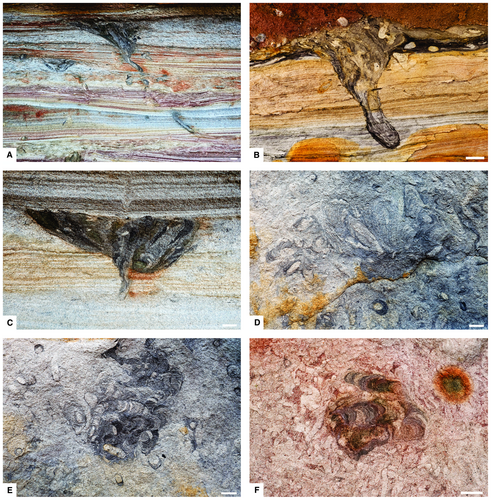
-
- * 86
-
- Rosselia rotatus McCarthy, p. 361, pl. 1, figs 2–3
Revised diagnosis
(After McCarthy 86) Rosselia with funnel containing passively filled terminal causative tubes and subvertical laminae, in plan view describing burrows with crescentic lamination or convolute patterns.
Remarks
Rosselia rotatus from the lower Permian (Asselian–Sakmarian) Wasp Head Formation of the southern Sydney Basin in Australia differs from R. socialis by having a ‘funnel [that] comprises finer grained sediment with intensively developed, crescentic backfill structures formed by rotary movements of the tube within the funnel’ (McCarthy 86, p. 361). Although this diagnosis may apply to the holotype representing one endmember of a morphological series with a wide range of variation, as demonstrated by McCarthy (86) and Bann (7), many other forms are tubular backfilled burrows that are not consistent with the diagnosis of Rosselia and Rosselichnidae. Given these uncertainties, Uchman & Krenmayr (126) regarded the features of R. rotatus as intraspecies variation of R. socialis, whereas Knaust (67) argued for including R. rotatus as a junior synonym of Parahaentzschelinia ardelia, a procedure followed by Luo et al. (81). Investigation of numerous specimens from the type locality confirms a wide range of morphologies transitional to R. socialis and having affinity with P. ardelia but justifies the validity of R. rotatus as an endmember of this morphological series (Fig. 6).
Producer and ethology
Tellinidae (Bivalvia) have been assumed to produce R. rotatus (Luo et al. 81), although vermiform organisms (e.g. polychaetes) cannot be ruled out (Bann 7; Knaust 68). Sediment-feeding by a sessile organism is the likely interpretation, combined with equilibrating burrow adjustment due to rapid deposition.
Stratigraphic distribution
Lower Permian (Asselian–Sakmarian; McCarthy 86; Bann 7; Luo et al. 81) to Pleistocene (D'Alessandro & Uchman 2007, fig. 5B). The report of Lower Ordovician R. rotatus by Bayet-Goll & Neto de Carvalho (1002) remains questionable.
Depositional environment
Marginal marine (deltaic, tidal) to shallow marine (shoreface).
Rosselia prolifera (Fournier et al., 34) comb. nov.
-
- * 34
-
- Polycylindrichnus prolifer Fournier et al., p. 738, fig. 1
Revised diagnosis
(After Fournier et al. 34) Branched, curved Rosselia.
Remarks
Branching justifies separation on the ichnospecies level, in analogy to Cylindrichnus candelabrus Głuszek, 47 (Fig. 1). Accordingly, branched Rosselia socialis as described by Uchman & Krenmayr (126, fig. 3c–e), Martino & Curran (1006, fig. 11e) and Humphreys & Balson (60) are included in R. prolifera.
Producer and ethology
Tunicata were originally assumed as the producers of R. prolifera (Fournier et al. 34), as well as Thalassinidea (Malacostraca; Humphreys & Balson, 60). Association with R. socialis suggests a similar producer, e.g. Terebellida (Polychaeta) or, less likely, Actiniaria (Anthozoa).
Stratigraphic distribution
Silurian (Llandovery; Fournier et al. 34) to Pliocene (Humphreys & Balson 60).
Depositional environment
Shallow marine (shoreface, subtidal).
Ichnogenus CYLINDRICHNUS Toots in Howard, 57
-
- non 5
-
- Cylindrichnus Bandel, p. 6; pl. 3, fig. 2; pl. 4, figs 1, 5; fig. 2,2 [= Margaritichnus Bandel, 6]
-
- ? 84
-
- Obliquus Marintsch & Finks, p. 1069, pl. 4, figs 4–7
-
- non 37
-
- Cylindrichnus pustulosus Frey & Bromley, p. 808, fig. 12a–b [resembles Bulbichnus Monaco, 88 and Neoeione Boyd & McIlroy, 14]
-
- non 25
-
- Cylindrichnus errans D'Alessandro & Bromley, p. 77, pl. 15, fig. 3 [= vertical spreiten burrow]
-
- 93
-
- [Psilonichnus] lutimuratus Nesbitt & Campbell, p. 893 [= nomen nudum]
-
- non 45
-
- Cylindrichnus helix Gibert et al., p. 81, fig. 9a [= helical trace, Gyrolithes]
Type ichnospecies
Cylindrichnus concentricus Toots in Howard, 57.
Revised diagnosis
(After Ekdale & Harding 33) Cylindrical burrow with circular or elliptical cross-section, forming a broadly arcuate shape, with concentric lining and passive fill. Secondary successive branching may occur.
Remarks
The continuing debate and uncertainty about the distinction of Cylindrichnus and Rosselia could be settled by the study of the holotype, paratype, and additional material from the type locality (Ekdale & Harding 33). Although their revised diagnosis of the type ichnospecies of Cylindrichnus, C. concentricus, states ‘… a broadly arcuate “U”-shape’, the ichnogeneric diagnosis still follows the older diagnosis of Frey & Howard (38) and includes ‘gently curved, … downward tapering burrows’. To avoid further confusion with Rosselia, the herein revised diagnosis of Cylindrichnus is restricted to broadly arcuate burrows. It also includes branched forms as considered in the diagnosis by Frey & Howard (38) and evidenced by C. candelabrus. Even though the holotype is incomplete, topotype material confirms narrow burrow entries that contrast with the significant funnel-shaped enlargements in Rosselia.
Obliquus Marintsch & Finks, 84 is an inclined cylindrical burrow with internal lamination, which ‘… may approach horizontality near its upper part’ and is tentatively included in Cylindrichnus. Cylindrichnus pustulosus Frey & Bromley, 37 consists of ‘subcylindrical, gently curved, thinly but concentrically walled burrows bearing inconsistently spaced coarse ridges and irregular large knobs’. It is known only from its type area, the Maastrichtian chalk of the Selma Group in western Alabama. The gently curved holotype burrow is only partly preserved and has a thinly lined wall. The holotype and topotype material from the type locality does not seem to have concentric lamination, hence its assignment to Cylindrichnus becomes questionable (A. Rindsberg, pers. comm. September 2020). The figured holotype (Frey & Bromley 37, fig. 12) shows a laminated basal burrow part and an upper part containing large sediment pads, which has affinity with Bulbichnus Monaco, 88 and Neoeione Boyd & McIlroy, 14. Cylindrichnus errans D'Alessandro & Bromley, 25 describes vertical burrows with a spreite-like displacement and differs in orientation, morphology and internal structure from Cylindrichnus and therefore is excluded from it (incertae sedis, Goldring 48).
Psilonichnus lutimuratus Nesbitt & Campbell, 93 was intended for naming ‘…vertical to very steeply inclined tubes that are lined with mud; circular in cross-section; tapering and slightly curved at base; Y-shaped … burrows’, but remains a nom. nud. due to lacking ‘…the explicit fixation of a holotype, or syntypes, for the nominal taxon’ (ICZN 61, Article 16.4.1). If this ichnospecies name were available, its accommodation in the ichnogenus Psilonichnus would be unfortunate because of its thick mud lining, as recognized by previous authors (e.g. Bedatou et al. 10; Genise 44). Judging from specimens figured in Nesbitt & Campbell (93, figs 2, 3), the ‘…cemented, smooth mud lining from 2–10 mm in thickness’ appears to be laminated, a feature that would justify inclusion in Cylindrichnus. Its Y-shaped branching is similar to C. candelabrus, from which it differs by a larger depth-to-width ratio (U-shaped versus bow-shaped). Restudying material from the type locality will show if P. lutimuratus can be re-established as an available ichnospecies, or if it can be included in C. candelabrus.
Cylindrichnus helix Gibert et al., 45 was erected for ‘…irregular sinusoidal to helicoidal configuration’ of Cylindrichnus but is not consistent with the diagnosis of Cylindrichnus. The overall morphology is now regarded as the primary ichnotaxobase (Bertling et al. 13; Knaust 66) and C. helix can be transferred to Gyrolithes, an ichnogenus that consists of smooth and walled, vertical helical burrows (Uchman & Hanken 125). The two valid ichnospecies of Cylindrichnus are illustrated in Figure 1.
Cylindrichnus concentricus Toots in Howard, 57Figure 7A–G
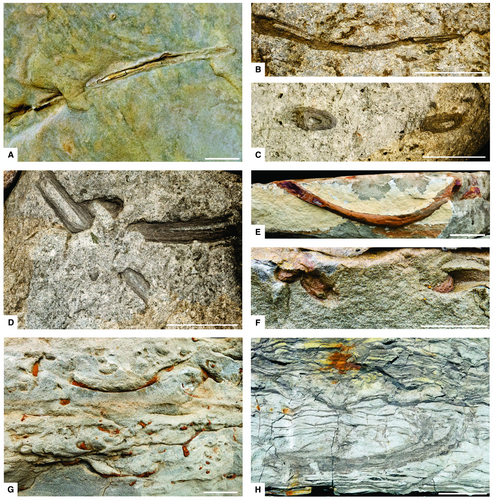
Revised diagnosis
(After Ekdale & Harding 33) Broadly arcuate, unbranched Cylindrichnus.
Remarks
The somewhat loose original definition of C. concentricus has led to confusion about its morphology and the distinction of Cylindrichnus from similar ichnogenera, such as Rosselia and Asterosoma (e.g. Howard 57; Frey 36; Frey & Howard 38; Goldring 48).
Producer and ethology
Although Goldring (48) found decapod crustaceans associated with concentrically laminated, bow-shaped burrows, Terebellida (Polychaeta) with a detritus-feeding behaviour (dwelling) are more likely producers of C. concentricus based on modern analogues (Aller & Yingst 1; Dashtgard et al. 28; Belaústegui & Gibert 11).
Stratigraphic distribution
Convincing C. concentricus are known from the upper Permian (Lopingian; Knaust 1005, 68) to the Miocene (Belaústegui & Gibert 11), whereas reports of older specimens back to the lower Cambrian remain dubious because of their unknown overall burrow morphology. Modern analogues were described by Dashtgard et al. (28).
Depositional environment
Shallow marine (shoreface, shelf), occasionally deep marine (slope).
Cylindrichnus candelabrus Głuszek, 47Figure 7H
-
- * 47
-
- Cylindrichnus candelabrus Głuszek, p. 526, fig. 7a
Revised diagnosis
(After Głuszek 47) U-shaped, upward-branched Cylindrichnus.
Remarks
Cylindrichnus candelabrus can be compared with Rosselia prolifera (Fournier et al. 34), the latter which does not describe a complete U but emerges in the bedding and develops an upward-branching, bow-shaped burrow. Incompletely preserved branched Cylindrichnus as figured by Knaust (68, fig. 5.49e) can be tentatively included in C. candelabrus (Fig. 7H).
Producer and ethology
Cylindrichnus candelabrus is interpreted as the dwelling of a worm-like organism feeding on detritus, analogous to the modern Terebellida Amphitrite ornata (Głuszek 47).
Stratigraphic distribution
Lower Carboniferous (Serpukhovian; Głuszek 47), Upper Cretaceous? (Campanian; Knaust 68).
Depositional environment
Marginal marine (paralic, deltaic, interdistributary bay fill).
Ichnogenus PATAGONICHNUS Olivero & López Cabrera, 97
Type ichnospecies
Patagonichnus stratiformis Olivero & López Cabrera, 97.
Revised diagnosis
(After Olivero & López Cabrera 97) Large, compound burrow system characterized by many distinctive concentrically laminated modules budding from an intricate system of horizontal to vertical, connected mud-lined tubes. Concentrically laminated components may consist of vertical to horizontal fusiform bulbs, bulbous swellings, helicoidal bulbs, and backfilled tubular branches. The burrow system tends to cover large, irregular, horizontal layers. Vertical, concentrically laminated shafts or cone-in-cone structures surrounding a lined tube may connect different levels.
Remarks
Patagonichnus differs from other ichnogenera in Rosselichnidae by including complex burrow systems in three dimensions (Fig. 1).
Patagonichnus stratiformis Olivero & López Cabrera, 97Figure 8A–D
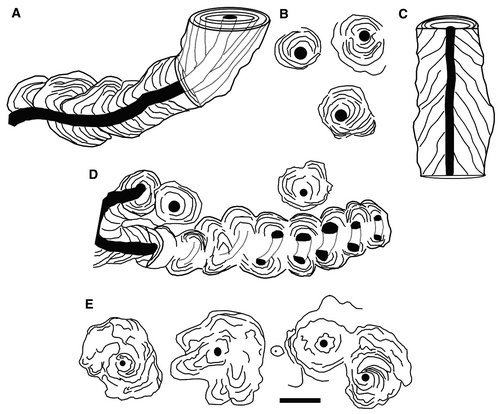
-
- * 97
-
- Patagonichnus stratiformis Olivero & López Cabrera, p. 8, fig. 6a–b
Revised diagnosis
(After Olivero & López Cabrera 97) Dominantly sinuous, crowded, long horizontal backfilled branches with successive bulbous lateral swellings surrounding a ramified, central mud-lined tube. Distal ends may be transitional to helicoidal bulbs and associated helicoidal inner tube. Distinct levels may be connected by straight, vertical, conical to helicoidal, concentrically laminated shafts.
Remarks
This ichnospecies diverges slightly from other ichnospecies of Rosselichnidae by including burrow elements with a backfilled mantle and passively filled core (like Siphonichnus), while other parts are concentrically laminated (Fig. 8A–D).
Producer and ethology
Patagonichnus stratiformis is interpreted as the feeding trace of gregarious Polychaeta (Olivero & López Cabrera 97).
Stratigraphic distribution
Upper Cretaceous (Maastrichtian; Olivero & López Cabrera 98) to Miocene (Olivero & López Cabrera 97).
Depositional environment
Shallow marine (tidal).
Patagonichnus calyciformis Olivero & López Cabrera, 97Figure 8E
-
- * 97
-
- Patagonichnus calyciformis Olivero & López Cabrera, p. 6, fig. 4f
Revised diagnosis
(After Olivero & López Cabrera 97) Series of dominantly linear arrays of vertical, calyx-shaped, concentrically laminated bulbs, budding from a horizontal lined tube (Fig. 8E).
Producer and ethology
Patagonichnus calyciformis is interpreted as the feeding trace of gregarious Polychaeta (Olivero & López Cabrera 97).
Stratigraphic distribution
Lower Cretaceous? (Hauterivian; Rodríguez-Tovar & Uchman 112), Miocene (Olivero & López Cabrera 97).
Depositional environment
Shallow marine (tidal). The deep-marine records of P. calyciformis from the Lower Cretaceous (Rodríguez-Tovar & Uchman 112) are incomplete and remain questionable.
Patagonichnus thalassiformis Olivero & López Cabrera, 97
-
- * 97
-
- Patagonichnus thalassiformis Olivero & López Cabrera, p. 9, fig. 6 g
Revised diagnosis
(After Olivero & López Cabrera 97) Long, dominantly horizontal and straight to curved, single, paired or multiple tubular branches and associated bulbs filled with conical or helicoidal, concentric laminae surrounding an intricate system of lined inner tubes. Horizontal parts may be connected with vertical and shorter backfilled branches. When the external backfilled structure is missing, the lined inner tube may form intricate, crowded gallery systems with numerous vertical and horizontal branches.
Remarks
Individual burrow parts of this complex trace fossil share features with other ichnospecies, particularly Lamellaecylindrica paradoxica and L. ludwigae.
Producer and ethology
Patagonichnus thalassiformis is interpreted as the feeding trace of gregarious Polychaeta (Olivero & López Cabrera 97).
Stratigraphic distribution
Miocene (Olivero & López Cabrera 97).
Depositional environment
Shallow marine (tidal).
Ichnogenus ARTICHNUS Zhang et al., 139
Type ichnospecies
Artichnus pholeoides Zhang et al., 139.
Revised diagnosis
(After Zhang et al. 139) Wide J-shaped cylindrical burrow with a pointed or hemispherical blind termination and a tapering aperture, or a shallow arcuate burrow. A passively filled lumen is enclosed by thick lamination, partly with spreite-like displacement. Longitudinal or oblique striation may occur on the outer margin of the burrow.
Remarks
A broadened and revised diagnosis of Artichnus is necessary to accommodate all three ichnospecies, which now include blind-ending J-forms as well as arcuate burrows (Fig. 1). The occurrence of individual versus aligned burrows, as well as the presence of a shaft, spreite and striation may serve as ichnotaxobases on the ichnospecies level.
Artichnus pholeoides Zhang et al., 139
-
- * 2008
-
- Artichnus pholeoides Zhang et al., p. 78, fig. 3
Original diagnosis
Wide J-shaped, generally cylindrical structure, turbinate in the distal part towards the blind termination, and tapering in the proximal part. The proximal part consists of a steeply upward bent, narrowing shaft, tapering upwards. The burrow lumen lies within a thickly laminated, short, vertical, mostly retrusive spreite, which is best developed in the lower part of the structure. The outer margin is longitudinally striated in some specimens.
Producer and ethology
Dwelling members of Holothuroidea with a suspension-feeding behaviour are the likely producers of A. pholeoides (Zhang et al. 139).
Stratigraphic distribution
Lower Jurassic (Hettangian–Sinemurian; Knaust 68) to Holocene (Ayranci et al. 4).
Depositional environment
Shallow marine (delta front, prodelta) to deep marine (lobes).
Artichnus giberti Belaústegui et al., 12
-
- * 12
-
- Artichnus giberti Belaústegui et al., p. 145; fig. 2a
Original diagnosis
Subhorizontal and mostly rectilinear ‘test tube’-shaped, cylindrical burrow, with a constant diameter throughout its length, a hemispherical and blind termination, and a smooth and thick laminated lining. In the most distal and lowermost part of the structure, this lining may consist of laminated, retrusive spreite.
Remarks
This second ichnospecies of Artichnus deviates from the originally given ichnogeneric diagnosis of Artichnus by lacking a steeply upward bent, narrowing shaft in the proximal part of the burrow.
Producer and ethology
Dwelling members of Holothuroidea with a suspension-feeding behaviour are the likely producers of A. giberti.
Stratigraphic distribution
Eocene to Miocene (Belaústegui et al. 12).
Depositional environment
Shallow marine (sublittoral).
Artichnus serialis isp. nov.Figure 9

LSID
urn:lsid:zoobank.org:act:1A676D40-207F-4392-9472-4F06CB7E723A
Derivation of name
From Latin serialis, meaning arranged in a series.
Holotype
Specimen on a fallen block in the field (Fig. 9A–D).
Type locality and horizon
Brongniartfjellet, Nathorst Land, north side of the Van Keulenfjorden, Spitsbergen (coordinates: 77°34′06.3″N, 15°52′00.6″E), lower part of the Battfjellet Formation (Eocene). See Knaust (69) for outcrop description and Helland-Hansen & Grundvåg (55) for geological background.
Diagnosis
Serially arranged, cylindrical, wide J-shaped to arcuate burrows with thick lamination and passive fill.
Description
Several specimens of this new ichnospecies were investigated in the outcrop of the type locality, of which the most complete and best preserved has been selected as the holotype, whereas the remaining specimens provide additional information. The holotype is incomplete and consists of a chain of 14 individual, very shallow, arcuate burrows following one after the other in unbroken sequence in a broad, semicircular manner on the bedding plane (preserved in hyporelief). Individual segments are 1.5–2.5 cm wide, 6–12 cm long and up to 2 cm deep, whereas segments of associated burrows are up to 17 cm long. The regularity of segmentation with tightly arranged and clearly defined segments at the end of one burrow changes to a more loosely arranged, irregular segmentation at the other. Weakly developed, diffuse striation in the longitudinal direction occurs along the bottom of some specimens. The burrow fill consists of crudely laminated sandy layers surrounding a passively sand-filled cylindrical core (lumen), which occupies less than half of the burrow.
Remarks
The size and weight of the block in its remote location were such a logistical challenge to the transport and depositing of it in a collection, that it was left in the field. Although not an optimal solution, ‘designation of an illustration of a single specimen as a holotype is to be treated as designation of the specimen illustrated’ (ICZN 61, Article 73.1.4).
Producer and ethology
As with Artichnus pholeoides and A. giberti, deposit-feeding members of Holothuroidea are good candidates for producing A. serialis.
Stratigraphic distribution
Eocene.
Depositional environment
Shallow marine (deltaic).
Ichnogenus LAMELLAECYLINDRICA Knaust, 70
Type ichnospecies
Spongia paradoxica Woodward, 134.
Diagnosis
Horizontal to oblique, ramified cylindrical burrow with a thick, concentrically laminated muddy wall and a passively filled sandy core.
Remarks
The erection of the ichnogenus Lamellaecylindrica became necessary to avoid confusion of this form with Thalassinoides paradoxicus Kennedy, 65. For discussion, see Knaust (70).
Lamellaecylindrica paradoxica (Woodward, 134)Figures 10, 11
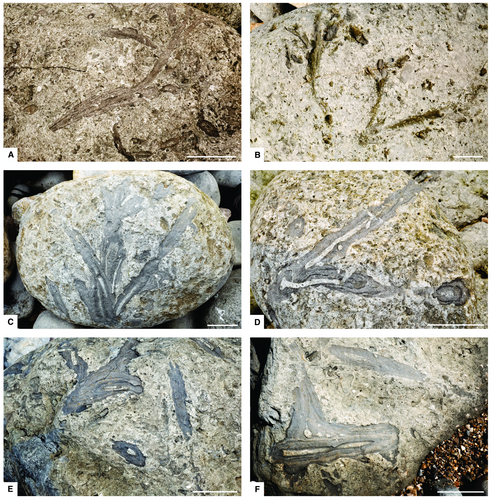
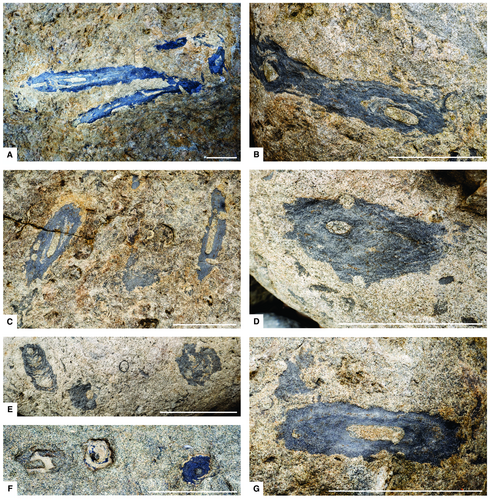
Lectotype
A selected specimen from the original drawing by Webster (131, pl. 27, fig. 1), as defined by Knaust (70).
Revised diagnosis
(After Knaust 70) Lamellaecylindrica with longitudinal striae (ornamentation) on the external surface.
Description
A description of this poorly known ichnospecies is appropriate here, given that Woodward (134) only referred to the description provided by Webster (131). New material (hundreds of specimens) studied in beach boulders (so-called cow stones) from the Lower Cretaceous (Albian) Upper Greensand Formation along the Undercliff south-west of Lyme Regis, Dorset, England (see Gallois 42; Gallois & Owen 43) reveals characteristic features and the morphological variability of L. paradoxica (Figs 10, 11).
Branched L. paradoxica occur closely together with unbranched forms of the same burrow type which belong to Cylindrichnus concentricus (Fig. 7B–D). Lamellaecylindrica paradoxica occurs as an elite trace fossil in totally bioturbated, glauconitic, fine-grained sandstone together with Nereites? isp., Palaeophycus heberti, Ophiomorpha irregulaire, Chondrites targionii, as well as scarce Taenidium irregulare and T. cameronensis. Some boulders preserve beds with hummocky cross-stratification, in which L. paradoxica occurs. Thin shell beds (coquina) mainly contain accumulated bivalve and gastropod clasts, whereas rare wood fragments are bioeroded (Teredolites isp.)
Although no entirely preserved burrow system could be found, the most complete systems consist of tunnels up to 45 cm long and which run parallel to slightly oblique to the assumed bedding. Primary and secondary successive branches occur in a bifurcate, palmate or fan-like manner, as well as T-branches with partly enlarged branching points. Burrows are 1.5–3.5 cm (commonly 2 cm) in diameter, circular to flat elliptical in cross-section, with an internal, passively sand-filled, cylindrical core of 0.3–0.8 cm (commonly 0.5 cm) in diameter. The core is surrounded by a thick sheath of dense (sub-millimetric thick), muddy laminae, the thickness of which can vary along individual burrows. Sand-filled burrows similar to the one present in the core can penetrate the laminated wall.
Burrow sections reveal a serrate outline, indicating deep striae on the burrow surface. An oblique to longitudinally striate surface can be confirmed by direct observation in washed-out (weathered) specimens. These striae may represent scratches or tension microfractures (cf. Seilacher 118, pl. 46). Bundling of two or more subparallel running tunnels can occur, as well as a thin basal spreite (similar to Teichichnus) due to vertical adjustment of the producer, which results in an eccentric position of the core.
Remarks
The overall morphology of L. paradoxica with plant-like bifurcation is similar to Keckia cylindrica von Otto in Geinitz, 0103 and Asterosoma? wohlfarthi (von Otto, 0101), which, however, lack a concentric lamination (Niebuhr & Wilmsen 96). There is a morphological resemblance to Phycodes palmatus (Hall, 51), but that ichnospecies displays vertical spreiten instead of concentric lamination. Cylindrichnus candelabrus Głuszek, 47 has a similar composition to L. paradoxica but differs from it by being U-shaped and upward-branched. The large, palmate, concentrically laminated burrow with striae from the Miocene of Patagonia described by Olivero & López Cabrera (97) can probably be assigned to L. paradoxica. There is a close resemblance to the burrow morphology and size of Patagonichnus thalassiformis Olivero & López Cabrera, 97, which differs from L. paradoxica by having conical or helicoidal laminae (i.e. inclined to the long axis of the burrow) instead of parallel concentric laminae.
Producer and ethology
Infaunal, deposit-feeding Holothuroidea or vermiform organisms (e.g. Polychaeta) would be capable of producing L. paradoxica, although decapod crustaceans cannot be ruled out. Rindsberg (0109) noted the thickly reinforced apertural lining of the crustacean burrow Thalassinoides Ehrenberg, 32 in soft to soupy substrates of a modern, brackish interdistributary bay, which could help to explain the origin of L. paradoxica. More detailed work is necessary to provide a robust interpretation of the trace maker and its behaviour.
Stratigraphic distribution
Lower Cretaceous (Albian; Knaust 70), probably Miocene (Olivero & López Cabrera 97).
Depositional environment
Shallow marine (shelf, tidal).
Lamellaecylindrica ludwigae (Schlirf, 114) comb. nov.Figure 12
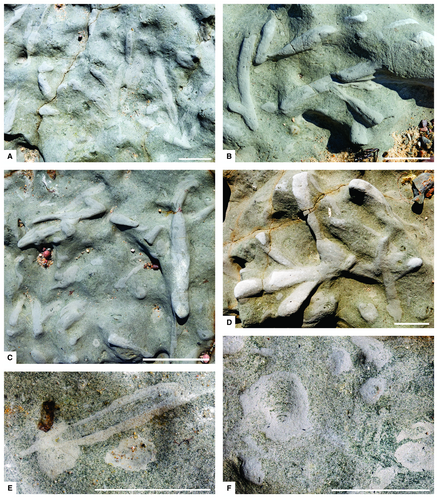
-
- * 114
-
- Asterosoma ludwigae Schlirf, p. 167, pl. 3, fig. 1
Revised diagnosis
(After Schlirf 114 and Neto de Carvalho & Rodrigues 94) Horizontal to vertical, downward-branching burrows with concentrically to irregularly laminated bulbs that bud from an elongate burrow with a circular to elliptical cross-section in a dichotomous to fan-like pattern.
Remarks
The ichnogenus Asterosoma, typified by A. radiciforme von Otto, 0101, has been defined as a circular, radiating (star-shaped) bulbous burrow (e.g. Fürsich 40; Häntzschel 54). Lamellaecylindrica ludwigae was originally assigned to Asterosoma by broadening its diagnosis to include star-like, dichotomous and fan-like forms (Schlirf 114). Neto de Carvalho & Rodrigues (94) provided a revised diagnosis of A. ludwigae, including vertical and horizontal burrows with concentric or irregular lamination and even massive fill. Bradshaw (15) revised the diagnosis of Asterosoma again and restricted it to circular, radiate forms, a view that was shared by Belaústegui and Gibert (11). Niebuhr & Wilmsen (96) also challenged Schlirf's diagnosis in favour of the restricted original diagnosis by von Otto (0101).
Because the type species of Asterosoma, A. radiciforme von Otto, 0101, is passively filled instead of laminated (Niebuhr & Wilmsen 96; Fig. 2), the laminated burrows with bulbous extensions discussed herein are assigned to Lamellaecylindrica as a new combination. Forms that probably can be included in L. ludwigae are burrows described by Carmona et al. (19, p. 95; fig. 3.3-4), Schlirf (114, pl. 4, figs 1, 10), Chamberlain (21, pl. 29, fig. 14) and Knaust (68, fig. 5.14e, f; Fig. 12). Lamellaecylindrica ludwigae differs from L. paradoxica by having the characteristic bulbous extension from the main burrow, although a transition field may exist.
Producer and ethology
Based on the overall morphology and presence of scratches, L. ludwigae is interpreted as the feeding trace of decapod crustaceans (Neto de Carvalho & Rodrigues 94). Analogous to similar and related forms, Holothuroidea and Polychaeta could also be potential producers. Lamellaecylindrica ludwigae from the Silurian (Llandovery) of Alabama shows intergradation with Arthrophycus that is interpreted as an arthropod (perhaps trilobite) burrow (Rindsberg & Martin 111).
Stratigraphic distribution
The confirmed stratigraphic distribution of L. ludwigae is lower Silurian (Llandovery; Rindsberg & Martin 111) to Upper Cretaceous (Coniacian–Santonian; Knaust 68), whereas younger records (Eocene, Knaust et al. 72; Miocene, Carmona et al. 19) are tentatively assigned to L. ludwigae and need further evaluation.
Depositional environment
Marginal marine (estuary, tidal; e.g. Schlirf 114; Rindsberg & Martin 111) and shallow marine (shelf; Knaust 68), less commonly, deep marine (lobes; e.g. Knaust et al. 72).
Ichnogenus BROMLICHNUS Vallon et al., 128
Type ichnospecies
Bromlichnus bromleyi Vallon et al., 128.
Diagnosis
As for B. bromleyi, see below.
Remarks
Bromlichnus becomes the youngest member of Rosselichnidae, a compound trace fossil consisting of two parts (Fig. 1).
Bromlichnus bromleyi Vallon et al., 128
Original diagnosis
Compound trace fossil consisting of: (1) an anterior triangular area with numerous circular to subcircular shallow pits with irregular rims; and (2) a posterior part comprising a very shallow, asymmetrically weakly bent burrow, originally bow-shaped, having a concentric spreite around a cylindrical, passively filled lumen.
Remarks
The very shallow burrow with a concentric spreite (i.e. lamination) around the cylindrical, passively filled lumen, as part of the compound trace fossil, resembles Artichnus (see Vallon et al., 128).
Producer and ethology
A deposit-feeding or suspension-feeding apodid Holothuroidea is assumed to be the likely producer of B. bromleyi.
Stratigraphic distribution
Upper Jurassic.
Depositional environment
Marginal marine (lagoonal).
Palaeobiology
Various interpretations of the potential producers and their behaviour represented by the different ichnogenera and ichnospecies included in the ichnofamily Rosselichnidae are provided based on the functional morphology of burrow elements and comparison with modern analogues. In general, animals of five classes are responsible for making individual ichnotaxa of Rosselichnidae: Polychaeta, Anthozoa, Holothuroidea, Bivalvia and Malacostraca. Suspension- and deposit-feeding polychaetes and holothurians account for most of the described members of Rosselichnidae (Fig. 13).
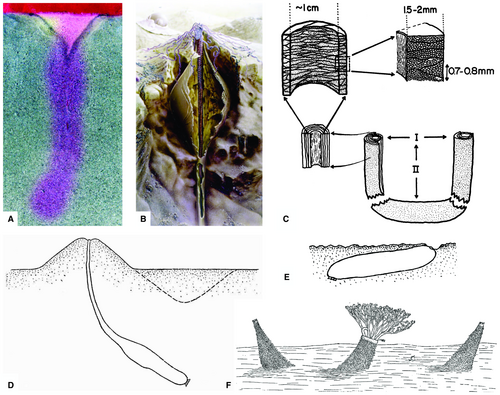
Suspension-feeding polychaetes are likely producers of Rosselia erecta, based on their simple burrow morphology containing a sand-filled shaft with a crudely laminated funnel at the top (Alpert & Moore 2). The spionid polychaete Marenzelleria viridis (Verrill, 129), which lives in blind-ended vertical burrows with a funnel-shaped aperture in sandy sediment, serves as a good modern example (e.g. Quintana et al. 0108; Kristensen et al. 75; Fig. 13A). Bioirrigation with pore-water transport along the burrow wall due to ciliary and muscular pumping may be responsible for the layering in the funnel region (Jovanovic et al. 64). In addition, biosedimentary processes related to funnel feeding as described in the maldanid polychaete Axiothella rubrocincta (Johnson, 63) may explain the layered funnel (e.g. Kudenov 76). Gregarious polychaete colonies have often been used as modern analogues to explain fossil pipe rocks with dense accumulations of R. erecta and Skolithos linearis (e.g. Barwis 8; McIlroy & Garton 2004). Hallam & Swett (52) compared R. erecta with burrows made by modern Cerianthidae (Anthozoa), based on Schäfer's (113) observations of the equilibrium behaviour of Cerianthus lloydi Gosse, 49 in shallow-marine sand of the North Sea. This comparison is unsatisfying because the resulting trace would be a series of nested cones (as illustrated by Schäfer 113, p. 326 and similar to the ichnogenus Conichnus Männil, 83), or vertical, Y-shaped, cylindrical burrows (as described by Frey (35) and similar to Polykladichnus Fürsich, 41), instead of a funnel-shaped aperture with a penetrating cylindrical tube. The producers of R. erecta were pioneers in colonizing stressed sandy substrate with changing sedimentation rates (Crimes et al. 24; McIlroy & Garton 2004).
Broad agreement exists in the interpretation of Rosselia socialis, the type ichnospecies of Rosselia, which in turn is the type ichnogenus of Rosselichnidae. Dahmer (27) suggested that R. socialis is the dwelling of a gregarious annelid worm, and later investigations and comparisons with modern analogues have confirmed that Terebellida (Polychaeta) with a detritus-feeding behaviour are its most likely producers (Nara 90, 91; Pemberton et al. 0103; Zorn et al. 140; Duperron & Scasso 31; Fig. 13B), beside other polychaetes (e.g. Spionidae; Olivero et al. 99). Likewise, the closely related R. prolifera was probably also produced by polychaetes. Actiniaria (Anthozoa) were presumed by Chamberlain & Clark 22) to produce Anemonichnus concentricus (= R. socialis), based on comparison with modern burrowing sea anemones. As with R. erectus, sea anemones would produce cone-in-cone structures with down-bent adjacent laminae similar to Conichnus, but without a penetrating sand shaft. Two phenomena are related to R. socialis, crowded occurrence (in contrast to individual) due to opportunistic colonization of its producer, and vertical stacking (equilibrium trace) in order to cope with high sedimentation rates (e.g. Nara 91; Frieling 39; Netto et al. 95; Buatois et al. 1001; Campbell et al. 18; Bayet-Goll et al. in press). The Rosselia ichnofacies was erected by MacEachern & Bann (82) for discriminating marine deltaic deposits from shoreface deposits.
The funnel-shaped aperture of R. rotatus partly resembles the ichnogenus Parahaentzschelinia, which has been attributed to the activity of tellinid bivalves (Knaust 67, 68; Luo et al. 81), although vermiform organisms cannot be ruled out (Chamberlain 21; Bann 7). Given that R. rotatus in its type area consists of a long, inclined tube instead of a cavity at the base of the funnel, bivalves are rather unlikely as trace makers and ‘worms’ need to be considered. Sediment ingestion by the funnel-feeding of a sessile organism in combination with equilibrium movements due to rapid sedimentation would be a plausible interpretation. This interpretation would be consistent with the closely associated traces, including backfilled burrows and spreite-like laminations. Alternatively, R. rotatus could also be explained as sequestrichnia, in which ‘the active introduction of mud to deeper tiers can be explained by a distinct feeding strategy: ingest nutritional mud at the surface, especially after fresh arrival, deposit it at depth beyond the range of shallowly burrowing sediment-feeders and within oxygen-deficient host sediment, and feed on such sequestered material during starvation times’ (Uchman & Wetzel 127).
Terebellid polychaetes with a detritus-feeding behaviour can also be regarded as the producers of Cylindrichnus concentricus and its branched relative C. candelabrus, as comparisons with modern analogues have shown (e.g. Amphitrite ornata (Leidy, 78); Aller & Yingst 1; Dashtgard et al. 28; Belaústegui & Gibert 11; Fig. 13C). Gregarious polychaetes are interpreted as the producers of the diverse and complex ichnospecies of Patagonichnus (Olivero & López Cabrera, 97).
General agreement exists about holothurians as the producers of the three ichnospecies of Artichnus (Zhang et al. 139; Belaústegui et al., 12; Ayranci et al. 4). This interpretation is arrived at via comparison with modern sea cucumbers, some of which burrow obliquely head-down into the sediment for the purpose of deposit-feeding. They create an excavation (e.g. lumen) that may be lined along its margin due to adjustment movements or change of size (e.g. contraction) of the animal and incorporation of foreign sediment. This excavation continues as a slender burrow to the sediment surface, made by the posterior part of the holothurian. Subvertical alignment of the posterior part and contraction of the cloacal muscles may explain the clear distinction of both body parts and the development of a shaft-like extension. Burrows similar in overall shape to Artichnus pholeoides have been described and illustrated from Paracaudina chilensis (J. Müller, 89) (e.g. Yamanouchi 135; Fig. 13D); that of A. giberti would be similar to Holothuria bivittata Mitsukuri, 87 (e.g. Yamanouchi 136; Fig. 13E), whereas the wide J-shaped to arcuate burrow elements in A. serialis could be produced by Thyone briareus Lesueur, 80 (e.g. Pearse 0102; Fig. 13F). The holothurians exploit a given area and sediment volume by processing it in the subsurface before entering a new area. If this shift in position occurs systematically, A. serialis would be the result.
Lamellaecylindrica paradoxica remains poorly understood, but transition to and co-occurrence with Cylindrichnus concentricus and the development of comprehensive burrow systems indicate a vagile deposit feeder, perhaps a polychaete. Rindsberg (0109) described large, onion-like Rosselia acting as the apertures of presumed Thalassinoides in the soupy mud of an interdistributary bay at the head of Mobile Bay, Alabama (USA), which could serve as an actualistic example of the ethologic function of the reinforcement of walls. Lamellaecylindrica ludwigae also remains enigmatic, and in addition to polychaetes, crustaceans, trilobites and holothurians are possible trace makers.
Facies and stratigraphy
Rosselichnidae consists of several ichnogenera and ichnospecies with various characteristics, each of which is known to occur in particular sedimentary environments. Although our knowledge of the different ichnospecies of Rosselichnidae remains scattered and varies from one ichnospecies to another, an analysis of their stratigraphic record and link to facies reveals significant trends (Fig. 14).
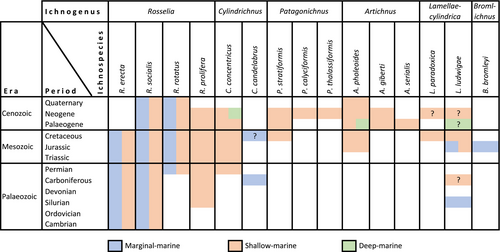
Rosselia, the oldest and best-known ichnogenus, is known from the Cambrian Stage 3 throughout the Phanerozoic, where it occurs in marginal-marine and shallow-marine environments with moderate to high depositional energy. Rosselia erecta, with its most basic features, is a common element of Cambrian Stage 3 nearshore to shoreface sandy deposits, but occasionally occurs in similar Palaeozoic and Mesozoic environments. Likewise, R. socialis has a long stratigraphic range from the Cambrian Stage 3 to the Holocene, where it commonly occurs either as a solitary specimen or crowded in tidal, estuarine, deltaic, nearshore, shoreface and shelf settings. Data on R. rotatus are more scattered and confirm a distribution from the lower Permian (Asselian–Sakmarian) to the Pleistocene in deltaic, tidal and shoreface deposits. Rosselia prolifera, a branched form similar to R. socialis, is known from Silurian (Llandovery) to Pliocene shoreface and subtidal deposits.
Cylindrichnus is another common trace fossil, but its taxonomic confusion with other ichnotaxa makes stratigraphic and facial mapping difficult. It ranges from the lower Carboniferous to the Holocene in marginal-marine to shallow-marine environments, with sporadic deep-marine excursions in the Cenozoic. Cylindrichnus concentricus is a common constituent of upper Permian (Lopingian) to Holocene deposits and preferably occurs in sandy shoreface and shelf successions, rarely in continental slope deposits. The questionable C.? pustulosus is known only from Upper Cretaceous chalk. Cylindrichnus candelabrus, a branched form otherwise similar to C. concentricus, is reported from lower Carboniferous paralic and deltaic deposits and tentatively from an Upper Cretaceous interdistributary bay fill.
Patagonichnus is a complex and relatively new ichnogenus, therefore its stratigraphic distribution is based on only a few records. It is known from Lower Cretaceous to Miocene shallow-marine (tidal) environments. Patagonichnus calyciformis has the longest range from the Lower Cretaceous to the Miocene, whereas P. stratiformis occurs from the Upper Cretaceous to the Miocene, and P. thalassiformis is known only from the Miocene.
Artichnus, another relatively young ichnogenus, is becoming successively more recognized as such, with a stratigraphic range from at least Lower Jurassic to Holocene, and shallow-marine to deep-marine settings. Artichnus pholeoides is known from Lower Jurassic to Holocene delta front, prodelta and deep-marine lobe deposits, whereas A. giberti occurs in Eocene–Miocene sublittoral environments, and A. serialis so far is known only from Eocene deltaic sandstone.
Lamellaecylindrica is another recently erected ichnogenus, but it is based on an old ichnospecies whose ichnotaxonomic controversy had hindered rigorous identification in particular strata and facies. It occurs in Lower Jurassic to probably Miocene deposits of a wide environmental range from marginal-marine to shallow-marine and, less commonly, deep-marine settings. A wider stratigraphic range is likely to emerge now that the taxonomy of this characteristic trace fossil has been resolved. Lamellaecylindrica paradoxica is confirmed to occur in Lower Cretaceous shelf sandstone and probably in Miocene tidal sandstone. Lamellaecylindrica ludwigae is known from Lower Jurassic to Upper Cretaceous estuarine, tidal, shelf and deep-marine lobe deposits.
Conclusion
The new ichnofamily Rosselichnidae is erected for burrows with a concentric, spiral or eccentric internal lamination. These morphological features apply to the ichnogenera Rosselia, Cylindrichnus, Patagonichnus, Artichnus, Lamellaecylindrica and Bromlichnus, together containing 15 ichnospecies. This nomenclatural act rationalizes the ichnofamily concept in ichnotaxonomy and the hierarchical structuring of ichnotaxobases for the assignment of ichnotaxa on various levels, such as the kind of trace fossil (e.g. burrow) and its composition (e.g. lamination) for the ichnofamily, burrow orientation and branching for ichnogenera, as well as branching patterns, proportion of active versus passive fill or ornamentation on the ichnospecies level. A critical revision of all included ichnospecies is provided, and type material and additional field specimens are illustrated. Moreover, potential trace makers and their inferred behaviour are discussed, together with an outline of the stratigraphic ranges of these ichnospecies. Based on this, a better utilization of trace fossils included in Rosselichnidae can be anticipated in future sedimentological, stratigraphic and phylogenetic studies.
Acknowledgements
I wish to express my gratitude to Ramues Gallois (Exeter), Anne-Grethe Hansen (Stavanger), William Helland-Hansen (Bergen) and Radek Mikuláš (Prague) for help related to my field work. Angela Ehling (Berlin), Christian Neumann (Berlin), Gunnar Riedel (Frankfurt) and Fredrik Söderblom (Lund) kindly assisted with the location of specimens from their collections. Sören Jensen (Badajoz) and the late S. George Pemberton (Edmonton) are thanked for sharing their views about Monocraterion. Eduardo Olivero (Ushuaia) kindly provided the original drawing for Figure 8. I am indebted to Andrew K. Rindsberg (Livingston) and Alfred Uchman (Cracow) for their thorough reviews of the manuscript.
Open Research
Data archiving statement
This published work and the nomenclatural act it contains, have been registered in ZooBank: http://zoobank.org/References/D64BEB6D-25D1-4A41-90B9-10D03E3619B3



